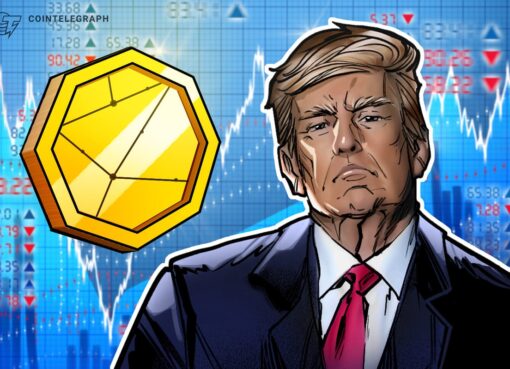How are analysts interpreting Bitcoin’s $97K consolidation against rising global debt maturity, ETF flow trends, and the uncertain direction of interest rates in the second half of the year?
Crypto mirrors the tension but charts its own path
The mood across global financial markets has turned visibly tense. What began as a focused concern around central bank decisions has morphed into a broader wave of uncertainty, shaped by conflicting macro indicators, uneven growth data, and investor hesitation.
The reintroduction of U.S. tariffs under President Donald Trump’s administration has added another layer of friction. A particularly bold move, such as the 100% tariff on foreign films, has not only reignited trade war concerns but also signaled a shift back to protectionist rhetoric.
For investors who had grown accustomed to relative trade stability, this has raised new questions about supply chains, international cooperation, and the policy outlook heading into the second half of the year.
Markets have already reacted. The S&P 500, which had gained steadily over the past few days, broke its streak as investors pulled back amid deteriorating macro signals.
In contrast, traditional safe-haven assets have seen rising inflows. Gold prices have edged upward, and Treasuries have gained traction again, a move often associated with risk aversion during economic softness.
Notably, the most recent GDP print disappointed expectations, while inflation has remained sticky around 3%, leaving the Federal Reserve in a difficult spot.
Rate cuts appear unlikely during Fed’s May 7 meeting, yet the tightening already in place may not be enough to shield against stagnation.
Jobless claims have begun ticking upward, and April’s CPI figures reflected consumer pressure that’s still far from easing.
The Treasury market’s absorption of a $42 billion 10-year bond sale is a notable development. It suggests institutional investors are repositioning for longer-term safety, likely preparing for potential policy missteps or a downturn that could surface without much warning.
Amid all this, the crypto market has found itself responding with its own brand of volatility. Bitcoin (BTC) reached an all-time high of nearly $109,000 in January, driven by ETF optimism, institutional inflows, and the broader narrative of crypto as a macro hedge.
But it wasn’t built on solid ground. Over the months that followed, BTC lost nearly 30% of its value before clawing back to around $97,000 as of this writing on May 7.
BTC still remains a strong asset in terms of performance year-to-date, but the erratic price swings have forced both retail and institutional players to reassess their strategies.
Let’s explore how current macroeconomic pressures, including recession risks, trade tensions, and monetary ambiguity are shaping investor behavior and what the coming months may hold for the crypto market.
Global trade system under pressure
A growing sense of macroeconomic fragility is beginning to shape investor expectations across asset classes. J.P. Morgan has placed the probability of a U.S. recession in 2025 at 60%, reflecting heightened concern over the systemic strain within the financial ecosystem.
Treasury markets continue to flash warning signs. The inversion of the 10-year and 3-month yield curve remains persistent, a traditional signal of recession risk.
Compounding the situation is the approaching maturity of over $6.5 trillion in the U.S. Treasury debt, a volume that could pressure liquidity and challenge the government’s refinancing capabilities in an already uncertain interest rate environment.
Charlie Hu, co-founder of Bitlayer, views this convergence of rising debt obligations and monetary policy uncertainty as a pivotal fault line in global capital markets.
“There are approximately $6.5 trillion USD worth of Treasury bonds approaching maturity in the coming months. The economic slowdown is putting pressure on the Fed’s interest rate and monetary policy decisions.”
He adds that a prolonged period of elevated rates, coupled with the urgency to refinance, could rattle investor confidence.
“If the market continues to experience high interest rates alongside a large volume of maturing debt that needs refinancing, the U.S. government will be forced to address the situation carefully — striking a balance between managing high inflation and high debt levels, the two biggest metrics influencing capital flow and investor behavior in global markets.”
This mounting pressure extends beyond the U.S. economy. The International Monetary Fund has issued repeated warnings about trade protectionism and retaliatory tariffs, labeling them as headwinds for global growth.
Recent policy actions have disrupted established supply chains, slowing cross-border trade and weakening the short-term outlook for export-heavy economies.
Amid these developments, the divergence between economic systems and behavioral responses has become more visible. Christian, founder of Infini, believes the disconnect is structural rather than cyclical.
“We’re seeing three core dislocations: one, the cost of capital has reset higher but consumer and government behaviors haven’t fully adjusted. Two, global supply chains are attempting to regionalize under nationalist pressures, yet our systems are still priced for globalization. And three, fiat confidence is eroding slowly, but the alternatives, digital or commodity-backed systems, haven’t matured enough to absorb that flow.”
Parallel concerns are surfacing around liquidity vulnerabilities. Tracy Jin, COO at MEXC, points to emerging fragilities in the bond market that could seep into broader risk asset pricing, including crypto.
“We’re closely monitoring a synchronized bond sell-off across US and emerging markets, especially the ones triggered by either sticky inflation or a fiscal credibility crisis.”
She notes that such scenarios, if left unchecked, could lead to a contraction in global liquidity and reduce the appetite for speculative assets.
ETF flows mask deeper trends
While traditional markets continue to react to inflation prints and central bank guidance, the crypto market is digesting a different cocktail, one that blends rising institutional interest with noticeable retail hesitation.
The gap between these investor classes is becoming increasingly evident, especially when viewed through the lens of ETF participation, derivatives trends, and sentiment data.
The Crypto Fear & Greed Index fell into “Extreme Fear” territory in April, typically a bearish signal. Yet Bitcoin defied this mood and climbed back toward $98,000.
This dissonance between sentiment and price has puzzled retail investors but, according to Jin, can largely be explained by the nature of capital flows.
“As Bitcoin approached $96,000, it underscores the bifurcation between sentiment and capital flows. ETF inflows from institutional channels have been a powerful counterforce to retail anxiety.”
She believes that much of the current turbulence is driven externally rather than from within the crypto ecosystem.
“We estimate that 60% of the current volatility can be accounted for by macro uncertainty, central bank ambiguity, and geopolitical risks. The rest can be accounted for from crypto-native elements, including miner capitulation post-halving and leveraged positioning in altcoins.”
The mechanics of ETF flows themselves have added to the confusion. Greco argues that ETF activity tends to reflect market moves rather than anticipate them, often introducing a timing lag that distorts real-time analysis.
“ETFs tend to mirror the broader market trend. During sharp declines, we typically see outflows, while strong rallies attract inflows. Many ETF products settle on a T+1 basis, meaning the reported flows usually correspond to the previous day’s activity.”
From his perspective, institutional flows act more as accelerators of existing direction rather than as early indicators of reversal or breakout.
Retail behavior, meanwhile, remains deeply reactive. Michael Cameron of Vanilla Finance highlights how crypto’s unique structure amplifies volatility during uncertain macro periods.
“Crypto’s high liquidity makes it a prime target for rapid sell-offs during economic stress. Unlike real estate or bonds, cryptocurrencies can be sold instantly on exchanges, amplifying downward price movements. Whales are buying dips, and a dovish FED or softer CPI could spark a rebound.”
Across the board, investors are parsing mixed signals. Institutional inflows may stabilize markets temporarily, but without clearer macro direction, both camps remain on edge, interpreting every data point, Fed speech, or CPI surprise as a possible turning point.
No past model fits this cycle
As recession probabilities rise and market uncertainty deepens, the question resurfaces, is crypto still a hedge, or has it been absorbed into the broader risk asset complex?
Jin believes Bitcoin’s growing institutional base may support a more nuanced response than a simple correlation or detachment from traditional markets.
“Bitcoin’s leverage lies in its maturing investor base, especially institutional participants via ETFs. As they could offer a partial buffer, we may see a nuanced decoupling. Broader equities could suffer a sharp pullback but Bitcoin could act less like a tech stock and more like a high-volatility hedge, especially if rate cut expectations increase.”
While that interpretation allows for divergence under certain macro scenarios, others remain doubtful of a clean break. Greco points to the increasing overlap between crypto and traditional finance, driven by institutional adoption, as evidence that both systems are now deeply intertwined.
“The general macro trends are usually similar. What really differs is the magnitude of the price swings between traditional finance and crypto, with the latter obviously experiencing much higher volatility in moments of high uncertainty. Looking at the past data point and the increasing commingling between the two markets, it looks unlikely that one sector might have a completely different pattern to the other.”
Some argue that the framing of recession itself needs to be rethought. Christian suggests that Bitcoin should not be viewed as a counter-cyclical hedge, but rather as a monetary alternative built to respond to systemic failure.
“A recession, in traditional terms, is a lagging indicator. But in first-principles terms, a recession is just a large-scale mispricing of risk and value, corrected through forced rebalancing. Bitcoin is what happens when a system opts out. It doesn’t need a soft landing — it is the hard alternative.”
That framework gains sharper relevance when viewed through the lens of geopolitical shocks and prolonged policy failure. Cameron stresses that while Bitcoin may gain in the long term from failed monetary policy, it is not insulated from short-term market trauma.
“The brief 2020 COVID recession saw crypto recover quickly due to stimulus and low rates, but a deeper, tariff-driven ‘Trumpcession’ could be different. Crypto has never endured a prolonged US recession since Bitcoin’s inception in 2009.”
Market awaits a catalyst
With the global macro backdrop still clouded by inflation, debt concerns, and geopolitical risk, market participants are shifting toward short-term caution while keeping one eye on longer-term opportunities.
Bitcoin has rallied nearly 25% over the past month, largely driven by institutional spot buying and ETF inflows. However, early signs of fatigue are beginning to show.
According to 10x Research, the Coinbase premium has dropped and funding rates have weakened, suggesting that momentum may be slowing.
The report notes that Bitcoin is now consolidating near the $95,000 level, with traders awaiting clearer signals from the Federal Reserve’s upcoming decisions.
“This is not a time for blind risk-taking but tactical positioning with well-defined exposure,” the research states, advising investors to consider hedging strategies as volatility creeps back in.
Cameron believes that while short-term weakness remains a concern, structural drivers continue to support long-term growth. He sees recession fears and ETF outflows contributing to current volatility, but also points to positive underlying trends.
Jin echoes that sense of cautious optimism. She expects Bitcoin to remain in a wide range as the market digests policy and liquidity signals.
“Bitcoin may trade in the $88,000–$100,000 range as the market digests macro signals and ETF flow data. Our year-end target remains cautiously bullish at $128,000, with the assumption of zero black swan event.”
Still, visibility remains limited. Greco describes the current price zone as crucial.
“The market is currently sitting at a crucial level that could shape sentiment over the coming weeks. A decisive break above the $94,000–$95,000 range could restore confidence in a sustained bullish trend.”
However, he stops short of any definitive forecast, noting that the cycle has already deviated from historical patterns.
“This one has already broken precedent by reaching a new all-time high before the halving, something never seen before.”
Christian suggests that the dominant market variable going forward may not be rate decisions or inflation data, but trust.
“The key variable now isn’t earnings or even rates. It’s trust. Trust in sovereign debt, in fiat, in central bank forward guidance. That trust has been bleeding.”
He sees Bitcoin and stablecoins as systems increasingly filling the vacuum left by waning institutional credibility.
As crypto enters the next phase of its market cycle, clarity will likely hinge on central bank action, global liquidity conditions, and the durability of institutional flows. In the meantime, the market remains in a holding pattern.
Summing it all up, risk is being recalibrated, conviction is being tested, and capital is watching for the next signal to move. Amid such fragile conditions, trade wisely and never invest more than you can afford to lose.




